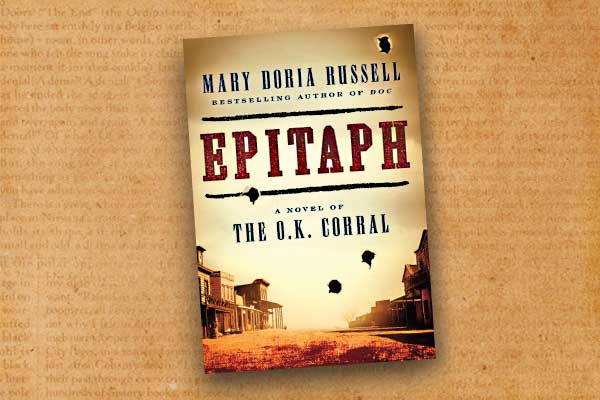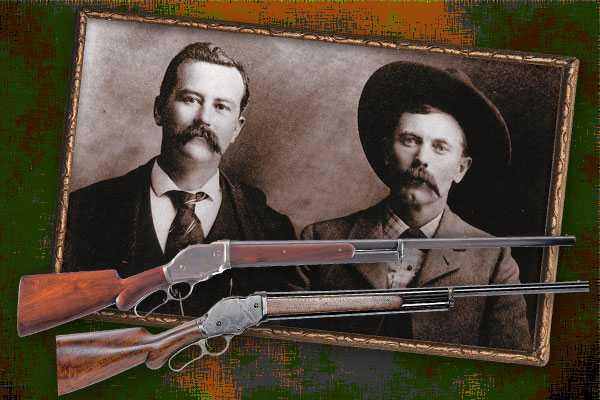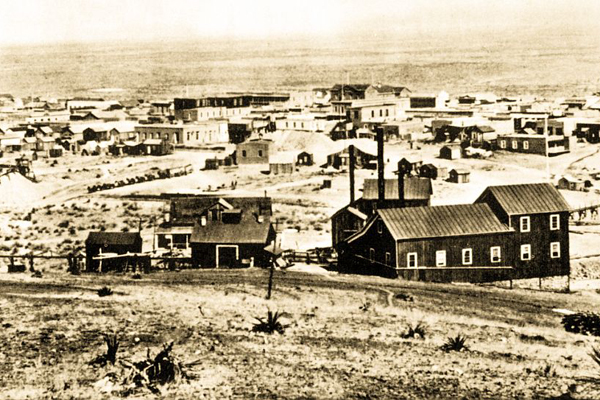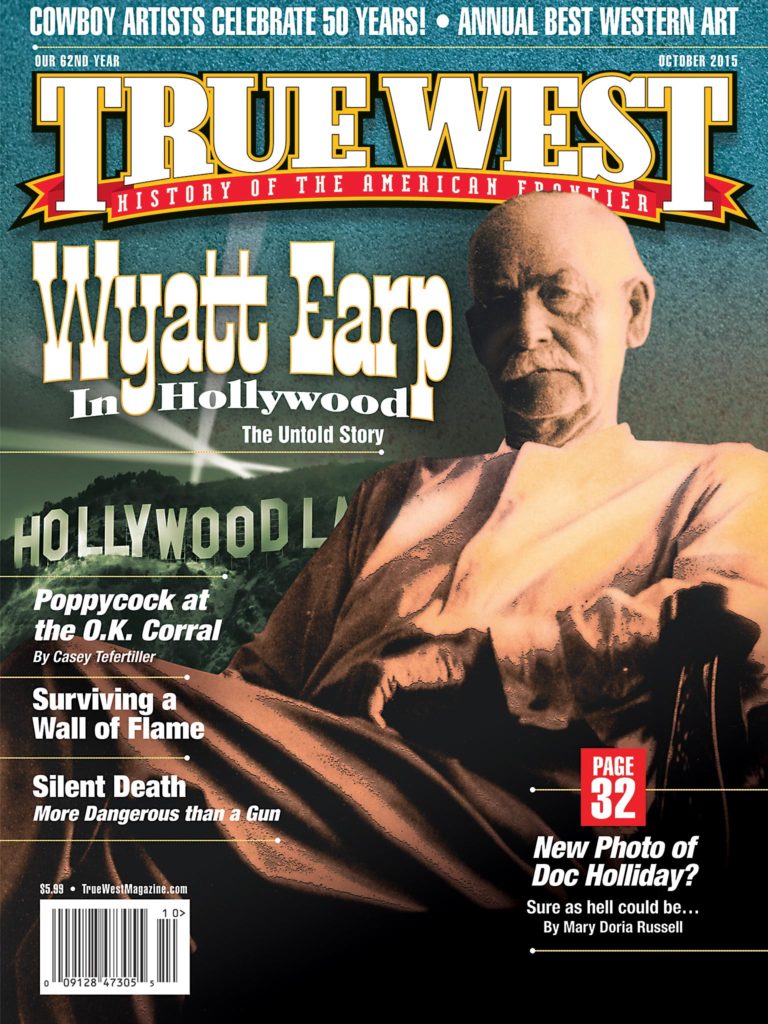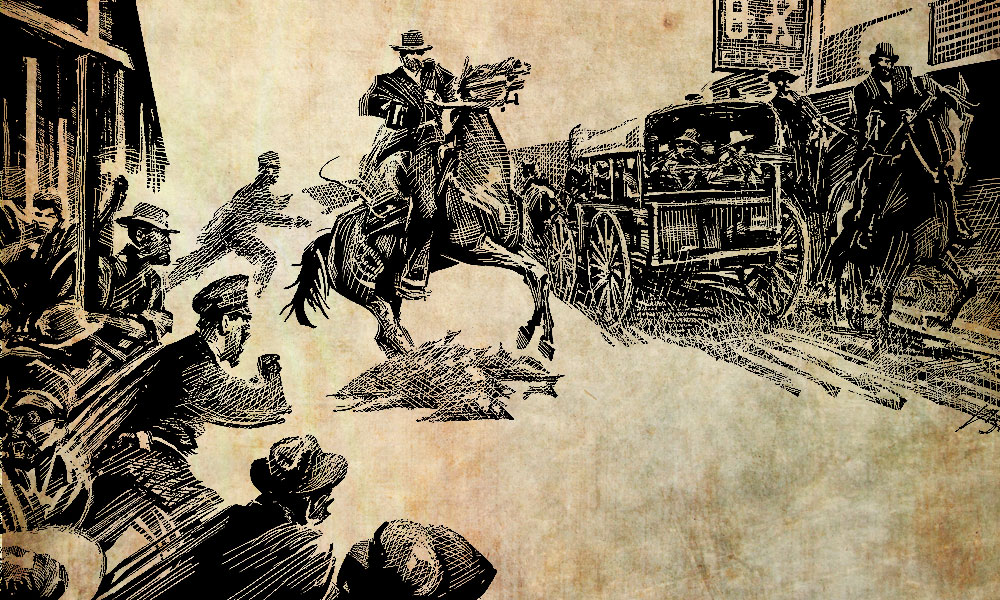
Illustration by Bob Boze Bell
Mike O’Rourke, 18, also known as Johnny-Behind-the-Deuce, and his roommate Robert Petty, 23, are eating in Smith’s restaurant in Charleston, Arizona.
It’s lunchtime, and Tombstone Mill & Mining Company’s chief engineer Phillip Schneider, 28, comes in and sits at the next table, joining A.E. Lindsey, a local telegraph operator.
Having finished his meal, O’Rourke gets up and walks over near the fireplace, sits on a stool and lights a cigar.
“You look cold Lindsey,” Schneider says to his table mate. Lindsey admits he has “about half a chill.”
O’Rourke says, “Yes, it is cold.”
“I ain’t talking to you,” says Schneider, who suspects the miner burglarized his cabin.
O’Rourke mutters, “Well, you’re a little too smart, anyhow.”
The mining engineer threatens O’Rourke, who heads for the door, yelling, “I will lick you when you come out.”
Waiting outside, O’Rourke is armed with Petty’s pistol, which he has retrieved from their room. He and Petty walk down near the corner of Frank Stilwell’s corral, where they again meet with the telegraph operator. “I think that old fellow is crazy,” says Lindsey, referring to Schneider.
All three decide to retire to a saloon for a drink, but as they turn to go up the street, they encounter Schneider, speedwalking toward them. He comes right up to O’Rourke and demands, “What the hell did you mean by talking to me in that way?”
Petty tries to intervene, but Schneider pushes him away, snarling at O’Rourke and saying, “I see you have got a pistol but you need not think that I am afraid of it.”
O’Rourke holds out his left hand, warning Schneider to stay away from him, but Schneider keeps coming as he pulls out a clasp-knife.
Constable George McKelvey has been watching the encounter. When O’Rourke pulls the pistol, the lawman runs toward them, shouting, “Don’t you shoot!”
The pistol discharges. The bullet hits Schneider above the upper lip on the left side of his nose, killing him instantly.
O’Rourke drops the weapon and runs toward the San Pedro River.
Constable McKelvey races up, grabs O’Rourke’s pistol and demands that O’Rourke stop, but he keeps running. McKelvey’s weapon misfires, so he fires O’Rourke’s pistol, successfully.
Johnny-Behind-the-Deuce stops immediately and is arrested. The fight is over, but the battle for the young gambler’s life has just begun.
With a gathering crowd looking for a rope to lynch the gambler, McKelvey loads the defendant into a buckboard and takes off for Tombstone. The enraged mob follows and almost overtakes the two when Virgil Earp shows up, while out exercising his brother Wyatt’s thoroughbred Dick Naylor. Taking in the scene at a glance, Virgil has O’Rourke jump up behind him and they take off for Tombstone.
Virgil and his prisoner arrive well ahead of the mob. Local law enforcement officers, led by Tombstone Marshal Ben Sippy, deposit the prisoner at Jim Vogan and Jim Flynn’s saloon and 10-pin bowling alley, until they can procure a wagon to take him to Tucson.
Tombstone Standoff
The Charleston mob is soon joined by miners from the Tombstone area, and they all, some 300 strong, descend on Tombstone’s Allen Street, looking for the prisoner. Upon seeing the killer being guarded by some local gamblers (Wyatt Earp, Doc Holliday and Charlie Smith), they jump to the conclusion that the gamblers are defending one of their own from justice. The crowd surges forward to confront the prisoner and his guards. The following description was reported in the January 17, 1881, edition of The Tombstone Epitaph:
“In a few minutes Allen Street was jammed with an excited crowd, rapidly augmented by scores from all directions. By this time Marshal [Ben] Sippy, realizing the situation at once…had secured a well armed posse of over a score of men to prevent any attempt on the part of the crowd to lynch the prisoner; but feeling that no guard would be strong enough to resist a justly enraged public long, procured a light wagon in which the prisoner was placed, guarded by himself, Virgil Earp and Deputy Sheriff [John] Behan, assisted by a strong posse well armed.
“Moving down the street, closely followed by the throng, a halt was made and rifles leveled on the advancing citizens, several of whom were armed with rifles and shotguns…Marshal Sippy’s sound judgment prevented any such outbreak…and cool as an iceberg he held the crowd in check.”
Wyatt Earp and the Mob
In two books, Walter Noble Burns’s Tombstone: An Iliad of the Southwest and Stuart Lake’s Wyatt Earp: Frontier Marshal, Wyatt Earp backs down the mob all by himself. This is at odds with the newspaper accounts, which do not mention Wyatt’s name (Tucson’s Arizona Weekly Citizen gives credit to “Deputy United States Marshal Virgil Earp and his companions”).
In 1928, however, Tombstone diarist George Parsons writes Lake that Wyatt displayed considerable “nerve” during the incident. Parsons writes, “…Wyatt, I could see him now as his team went down the street, he backed his horse down the street fronting the mob and lowered his rifle every now and then on them when a rush was attempted.” He adds, “It was a very nervy proposition, particularly on the part of Wyatt.”
Wyatt most likely did help his brother Virgil and City Marshal Ben Sippy hold back the mob. But, in light of the known record, thinking Wyatt did so all by himself is preposterous.
Aftermath: Odds & Ends
A 15-man Arizona posse rode with Pima County Deputy Sheriff John Behan, Charleston Constable George McKelvey and Tombstone Marshal Ben Sippy for 12 miles. Although the mob made threats to intercept the posse in Pantano, by taking a shortcut, no action materialized. The prisoner was delivered without incident to the Tucson jail.
On February 1, 1881, Justice Joseph Neugass ordered that Mike O’Rourke be held in the county jail, without bail, to await trial for his murder charge. Before the next grand jury convened, O’Rourke escaped on April 18, 1881, while he and other prisoners were in the jail yard prior to the evening lockdown. The Tombstone Epitaph speculated that, for about 20 seconds, the prisoners were out of the guards’ sight; of O’Rourke, the paper reported, someone “threw him up so that he could grasp the top of the wall.” No easy task, since the wall was a reported 16 feet high. The grand jury officially indicted O’Rourke on May 19.
The last sighting of O’Rourke was reported in The Tombstone Epitaph on May 13, 1881: “‘Johnny-Behind-the-Deuce’ was seen three days ago, we are informed, in the Dragoon Mountains. He was well mounted and equipped, and was on the eve of departure for Texas. The climate of Arizona, he said, did not agree with him.”
The fears of the Charleston miners came true: O’Rourke escaped justice.
Recommended: Classic Gunfights: Volume Two by Bob Boze Bell, published by Tri Star-Boze Publications


